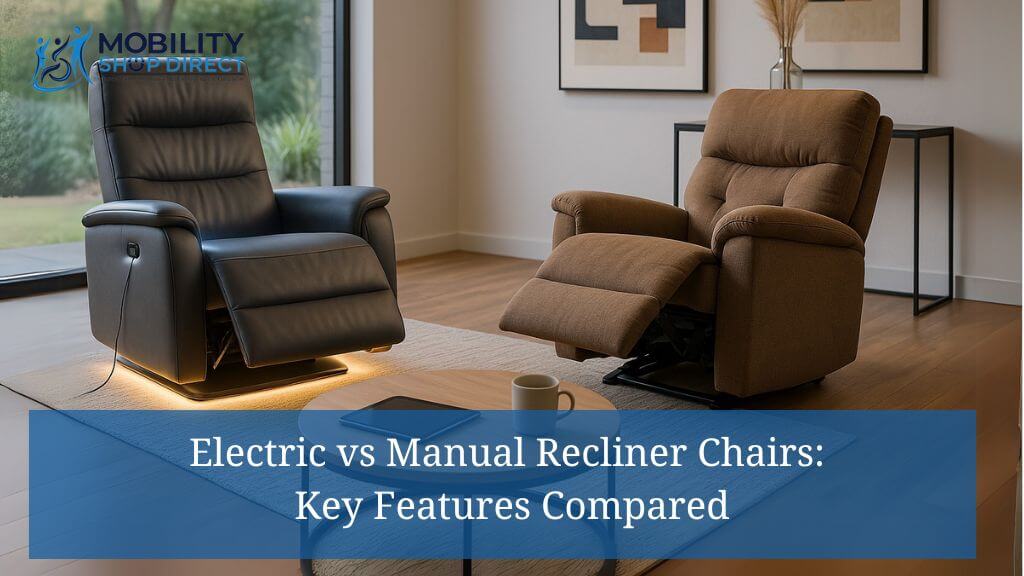Choosing the perfect recliner goes beyond prioritizing comfort—it's about seamlessly blending functionality, design, and practicality with your lifestyle. Do you value the ease of a motorized chair’s adjustment capabilities, or does the simplicity and reliability of a manual, lever-operated recliner align more with your priorities? The right decision can transform not only how you relax but also how it supports your daily needs, especially when considering factors such as mobility, maintenance, and long-term value.
This comprehensive guide will illuminate the key differences between electric and manual recliner chairs. By diving into aspects such as convenience, usability, cost efficiency, and reliability, we’ll equip you with the knowledge to confidently choose the ideal option for your home and personal lifestyle.
Ready to delve deeper into the world of recliners? Let’s break down the features that matter most and explore the pros and cons of each type.
Table of Contents
- Mechanics & Operation
- Ease of Use
- Cost & Value
- Maintenance & Placement
- Decision Guide
Mechanics and Operation Differences
How Do Electric Recliner Chairs Work?
Electric recliner chairs operate using motorized mechanisms that allow you to adjust their position effortlessly. By pressing a button on a remote control or built-in panel, you can recline, elevate the footrest, or even return to an upright position with minimal effort. Some models also include advanced settings such as memory presets to save your favorite positions, massage therapy, or heating features for added convenience and luxury.
High-end electric recliners, such as power lift chairs, are especially advantageous for individuals with mobility challenges. These chairs help users transition from seated to standing positions by gently raising and tilting forward. Designed for comfort and accessibility, electric recliners provide unparalleled ease of operation that appeals to a wide variety of users.
In essence, electric recliners are engineered for those who value seamless functionality and customizable comfort at their fingertips.
How Manual Recliners Operate
Manual recliners, in contrast, rely on mechanical components and physical input to adjust their position. Actions such as pulling a lever or applying body pressure allow the chair to recline or activate the footrest. Push-back recliners are another variation where you leverage your weight to tilt the backrest and extend the chair’s reclining feature.
The simplicity of manual recliners enhances reliability but requires some level of physical strength and coordination. For those who prefer a hands-on approach and value straightforward, maintenance-free mechanisms, manual recliners deliver a practical and user-controlled experience.
While they lack the advanced features of electric recliners, manual chairs are an excellent option for users who prioritize durability and independence without relying on additional technology.
Key Comparison: Electric vs Manual Recliner Chairs Mechanisms
The primary distinction lies in automation versus manual effort. Electric recliners excel in smooth, button-operated adjustments powered by motors, making them ideal for individuals who seek comfort and convenience. Meanwhile, manual recliners rely solely on user effort, offering increased durability and low-maintenance usage but requiring some physical strength and coordination.
Next, we’ll review which design aligns best with specific accessibility and lifestyle needs.
Ease of Use and Accessibility
Why Electric Recliners Are Ideal for Mobility Issues
Electric recliners are unmatched when it comes to providing comfort and functional support for individuals with mobility limitations. Their motorized mechanisms eliminate the need for physical effort, enabling easy transitions between upright, reclined, and lifted positions. For seniors, individuals with arthritis, or those recovering from surgery, features like power lift assistance can make a world of difference by reducing strain during daily movements.
User-friendly designs with remote controls or built-in buttons allow effortless operation, even for those with limited dexterity. Electric recliners are designed for those seeking both comfort and accessibility, making them a perfect solution for enhanced independence.
The Physical Effort Needed for Manual Recliners
Manual recliners, on the other hand, demand varying levels of physical engagement. Operating these chairs often involves leveraging body weight or activating a lever mechanism to adjust the recline or extend the footrest. While this may suit physically active users or those who enjoy a tactile experience, it presents challenges for individuals with reduced arm strength or mobility issues.
Despite their physical constraints, manual recliners offer reliable functionality without the need for an electrical power source, earning them a reputation for simplicity and cost efficiency.
Electric vs Manual in Terms of Daily Convenience
In terms of daily convenience, electric recliners stand out for their adaptability and range of features. Whether you're unwinding after work or recovering from an injury, the push-button controls make adjusting positions remarkably easy. Added functions like massage therapy, heated seats, or memory settings enhance convenience further.
Conversely, manual recliners excel in straightforward use. They don't rely on electricity or outlets, making placement flexible and their operation consistent even during a power outage. For users who value minimalism and self-reliance, manual recliners remain an appealing choice.
Having examined usability, let’s assess how budget considerations influence your decision.
Cost and Long-Term Value
Initial Cost Differences
At first glance, electric recliners often have a higher upfront cost compared to manual models. This price differential stems from the inclusion of motors, advanced features (e.g., heat and massage), and power-lift technology. Depending on your desired add-ons, prices can escalate into premium-tier ranges.
Manual recliners, by contrast, are typically more affordable and offer excellent value for budget-conscious buyers. If you need a reliable, straightforward chair without too many extras, manual recliners represent a cost-efficient choice.
Are Electric Recliners Worth the Investment?
Although more expensive initially, electric recliners often justify their price tag with the added comfort, accessibility, and functionality they provide. For individuals needing assistance with mobility or those who prioritize enhanced relaxation features like massage and heating, these chairs quickly pay for themselves in terms of convenience and well-being.
Further, warranties that cover motors and electrical components often ensure peace of mind and longevity for the investment.
Cost Efficiency in Manual Over Time
Over time, manual recliners prove their value through durability and minimal maintenance costs. With fewer components to maintain or repair, they offer reliable performance for years without significant expense. For users prioritizing long-term affordability paired with robust structure, manual recliners are an ideal solution.
Let’s now explore the maintenance side of both options.
Maintenance and Reliability
Maintenance Requirements for Electric Recliners
Electric recliners require more maintenance due to their motorized systems. Over time, components like motors or wiring may need servicing or replacement. To extend their lifespan, regular care and occasional technical check-ups are recommended. Additionally, power outages may necessitate investing in models with battery backup functionality to avoid disrupted use.
Simplicity of Manual Recliner Maintenance
Manual recliners shine in their low-maintenance nature. With no electrical systems to fail, upkeep typically involves light cleaning and lubricating the mechanism. Their simplicity makes them perfect for those seeking a hassle-free, long-lasting piece of furniture.
Durability Comparison: Which Recliner Type Lasts Longer?
Durability depends on factors such as construction quality and usage. While electric recliners feature advanced components, their electronic parts are susceptible to wear over time. Manual recliners, on the other hand, boast longer lifespans with proper care due to their simple and robust mechanical design. If long-term reliability and minimal intervention appeal to you, a manual recliner could be the better investment.
Power Dependency and Placement Considerations
Electric Recliners: Power Considerations
Electric recliners require proximity to an outlet, limiting placement options. However, many models offer battery backups to mitigate risks during power outages. Understanding how these chairs function can be helpful—check out our simple breakdown of how electric recliner chairs work for deeper insight.
Manual Recliners: Flexible Placement
Manual recliners are entirely independent of electrical sources, offering complete freedom in furniture arrangement. Whether placed near power outlets or not, these chairs remain fully operational in any room.
Choosing the Right Recliner for Your Lifestyle
To find your perfect recliner:
- Assess your needs—Do you require accessibility features or prefer simplicity?
- Consider long-term benefits—Is it more important to save upfront or invest in advanced features?
- Evaluate placement options—Do you need flexibility in room layout?
- Match materials and aesthetics to your decor for the ideal blend of form and function.
For more options to suit your individual needs, you can browse our full range of electric recliners.
Key Takeaways
- Mechanics: Electric recliners provide motorized ease; manual recliners rely on physical effort.
- Ease of Use: Electric recliners are optimal for reduced mobility; manual chairs are simple and reliable.
- Cost: Electric models cost more initially but offer advanced functionality; manual recliners are budget-friendly over time.
- Maintenance: Electric recliners need more upkeep; manual recliners are low-maintenance.
- Placement: Electric recliners require outlets; manual ones offer unrestricted positioning.
Conclusion
Ultimately, whether you opt for an electric or manual recliner depends on balancing comfort, budget, and lifestyle preferences. Electric options excel in convenience, advanced features, and functionality, particularly for users with specific accessibility needs, while manual recliners provide unmatched simplicity, durability, and cost efficiency. Evaluate your priorities, and let your next recliner bring lasting comfort to your relaxation routine.



